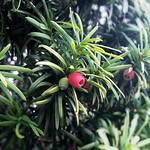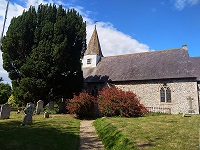Yew
The native yew is surrounded by history and folklore. The Ancient Greeks dedicated it to Hecate, goddess of the underworld. Known as the 'tree of death', some cultures thought it was abundant in hell. It is also associated with Bacchus, god of wine and Artemis, goddess of hunting, who dipped her arrows in yew poison. Highland clansman were said to have drawn on its magical powers to threaten enemies. All this may account for its presence in so many Scottish churchyards. The wood was used to make English longbows, knife handles and furniture. Today the highly toxic sap is the source of the drug Taxol used to treat cancer.

English Longbow made of yew
Image credit: Hitchhiker89 at English Wikipedia, Public domain, via Wikimedia Commons
Yew is Clan Seton's plant badge. The signature of one Alexander Seton connects the yew with what is perhaps the most important document held in the National Records of Scotland - the Declaration of Arbroath (1320) during the reign of Robert I 'The Bruce' (1316-1390).
The 5th Lord Seton, George Seton (c. 1527-1558) was a staunch catholic and former Provost of Edinburgh. A firm supporter of Mary Queen of Scots (1542-1587), his daughter was one of the four Marys sent to France with the young Queen in 1548. Mary Seton (1549-1615) returned with the Royal party in 1561 and remained with the Queen until her execution. She retired to a French nunnery.

